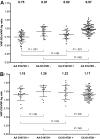Common VWF exon 28 polymorphisms in African Americans affecting the VWF activity assay by ristocetin cofactor
- PMID: 20231421
- PMCID: PMC2910611
- DOI: 10.1182/blood-2009-10-249102
Common VWF exon 28 polymorphisms in African Americans affecting the VWF activity assay by ristocetin cofactor
Abstract
The diagnosis of von Willebrand disease relies on abnormalities in specific tests of von Willebrand factor (VWF), including VWF antigen (VWF:Ag) and VWF ristocetin cofactor activity (VWF:RCo). When examining healthy controls enrolled in the T. S. Zimmerman Program for the Molecular and Clinical Biology of von Willebrand disease, we, like others, found a lower mean VWF:RCo compared with VWF:Ag in African American controls and therefore sought a genetic cause for these differences. For the African American controls, the presence of 3 exon 28 single nucleotide polymorphisms (SNPs), I1380V, N1435S, and D1472H, was associated with a significantly lower VWF:RCo/VWF:Ag ratio, whereas the presence of D1472H alone was associated with a decreased ratio in both African American and Caucasian controls. Multivariate analysis comparing race, SNP status, and VWF:RCo/VWF:Ag ratio confirmed that only the presence of D1472H was significant. No difference was seen in VWF binding to collagen, regardless of SNP status. Similarly, no difference in activity was seen using a GPIb complex-binding assay that is independent of ristocetin. Because the VWF:RCo assay depends on ristocetin binding to VWF, mutations (and polymorphisms) in VWF may affect the measurement of "VWF activity" by this assay and may not reflect a functional defect or true hemorrhagic risk.
Figures







Comment in
-
Redeeming ristocetin.Blood. 2010 Jul 15;116(2):155-6. doi: 10.1182/blood-2010-04-276394. Blood. 2010. PMID: 20634385 No abstract available.
Similar articles
-
Gain-of-function GPIb ELISA assay for VWF activity in the Zimmerman Program for the Molecular and Clinical Biology of VWD.Blood. 2011 Feb 10;117(6):e67-74. doi: 10.1182/blood-2010-08-299016. Epub 2010 Dec 10. Blood. 2011. PMID: 21148813 Free PMC article.
-
Laboratory Testing for von Willebrand Factor Ristocetin Cofactor (VWF:RCo).Methods Mol Biol. 2017;1646:435-451. doi: 10.1007/978-1-4939-7196-1_32. Methods Mol Biol. 2017. PMID: 28804846
-
Comparison of Von Willebrand factor (VWF) activity VWF:Ac with VWF ristocetin cofactor activity VWF:RCo.Thromb Res. 2014 Aug;134(2):246-50. doi: 10.1016/j.thromres.2014.04.033. Epub 2014 May 17. Thromb Res. 2014. PMID: 24891215
-
Laboratory diagnosis of von Willebrand disease type 1/2E (2A subtype IIE), type 1 Vicenza and mild type 1 caused by mutations in the D3, D4, B1-B3 and C1-C2 domains of the von Willebrand factor gene. Role of von Willebrand factor multimers and the von Willebrand factor propeptide/antigen ratio.Acta Haematol. 2009;121(2-3):128-38. doi: 10.1159/000214853. Epub 2009 Jun 8. Acta Haematol. 2009. PMID: 19506359 Review.
-
Dominant von Willebrand disease type 2A groups I and II due to missense mutations in the A2 domain of the von Willebrand factor gene: diagnosis and management.Acta Haematol. 2009;121(2-3):154-66. doi: 10.1159/000214856. Epub 2009 Jun 8. Acta Haematol. 2009. PMID: 19506362 Review.
Cited by
-
Comparison of von Willebrand factor platelet-binding activity assays: ELISA overreads type 2B with loss of HMW multimers.J Thromb Haemost. 2020 Oct;18(10):2513-2523. doi: 10.1111/jth.14971. Epub 2020 Aug 27. J Thromb Haemost. 2020. PMID: 32573891 Free PMC article.
-
Thrombocytosis with acquired von Willebrand disease in an adolescent with sickle cell disease.Clin Case Rep. 2020 Nov 20;9(1):457-460. doi: 10.1002/ccr3.3556. eCollection 2021 Jan. Clin Case Rep. 2020. PMID: 33489197 Free PMC article.
-
The common VWF variant p.Y1584C: detailed pathogenic examination of an enigmatic sequence change.J Thromb Haemost. 2024 Mar;22(3):666-675. doi: 10.1016/j.jtha.2023.11.016. Epub 2023 Nov 30. J Thromb Haemost. 2024. PMID: 38040335 Free PMC article.
-
Gender, race and diet affect platelet function tests in normal subjects, contributing to a high rate of abnormal results.Br J Haematol. 2014 Jun;165(6):842-53. doi: 10.1111/bjh.12827. Epub 2014 Mar 12. Br J Haematol. 2014. PMID: 24617520 Free PMC article.
-
Critical von Willebrand factor A1 domain residues influence type VI collagen binding.J Thromb Haemost. 2012 Jul;10(7):1417-24. doi: 10.1111/j.1538-7836.2012.04746.x. J Thromb Haemost. 2012. PMID: 22507569 Free PMC article.
References
-
- Rodeghiero F, Castaman G, Dini E. Epidemiological investigation of the prevalence of von Willebrand's disease. Blood. 1987;69(2):454–459. - PubMed
-
- Sadler JE, Mannucci PM, Berntorp E, et al. Impact, diagnosis and treatment of von Willebrand disease. Thromb Haemost. 2000;84(2):160–174. - PubMed
-
- Sadler JE, Budde U, Eikenboom JC, et al. Update on the pathophysiology and classification of von Willebrand disease: a report of the Subcommittee on von Willebrand Factor. J Thromb Haemost. 2006;4(10):2103–2114. - PubMed
-
- Tosetto A, Rodeghiero F, Castaman G, et al. Impact of plasma von Willebrand factor levels in the diagnosis of type 1 von Willebrand disease: results from a multicenter European study (MCMDM-1VWD). J Thromb Haemost. 2007;5(4):715–721. - PubMed
-
- Kitchen S, Jennings I, Woods TA, Kitchen DP, Walker ID, Preston FE. Laboratory tests for measurement of von Willebrand factor show poor agreement among different centers: results from the United Kingdom National External Quality Assessment Scheme for Blood Coagulation. Semin Thromb Hemost. 2006;32(5):492–498. - PubMed
Publication types
MeSH terms
Substances
Grants and funding
LinkOut - more resources
Full Text Sources
Miscellaneous

